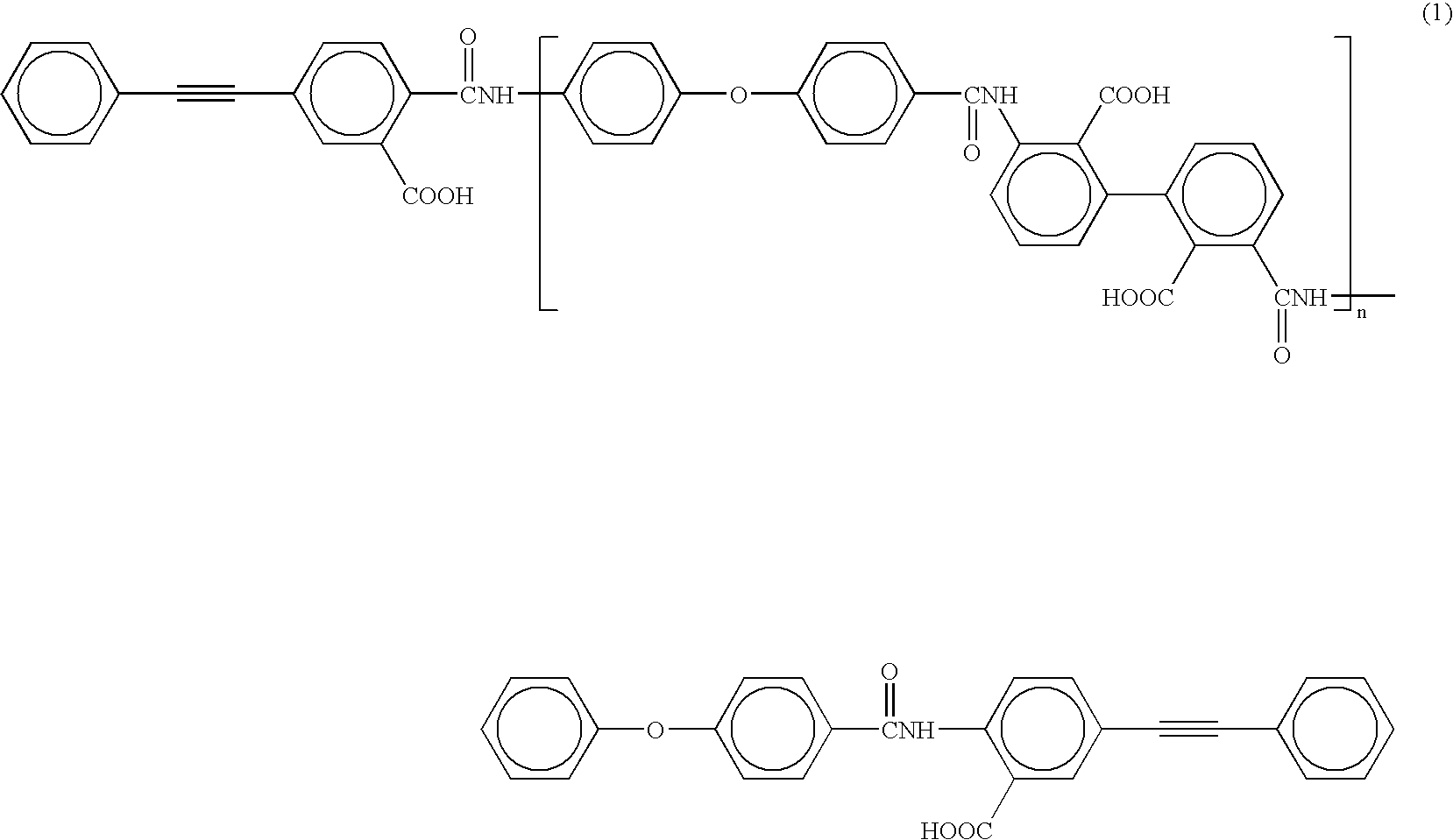Polyamic acid oligomer, polyimide oligomer, solution composition, and fiber-reinforced composite material
- Summary
- Abstract
- Description
- Claims
- Application Information
AI Technical Summary
Benefits of technology
Problems solved by technology
Method used
Image
Examples
example 1
7.1 Example 1
A reaction vessel equipped with an electromagnetic stirrer was charged with 4.005 g (0.020 mol) of oxydianiline (4,4′-diamino diphenyl ether; hereinafter abbreviated as “ODA”). After the addition of 40 mL of N,N-dimethylacetamide (hereinafter abbreviated as “DMAc”) which was dehydrated and purified by distillation, ODA was dissolved with stirring. After the addition of 2.942 g (0.020 mol) of sufficiently dried 2,2′,3,3′-biphenyltetracarboxylic dianhydride (hereinafter abbreviated as “i-BPDA”) in powdery form to the reaction system, the mixture was polymerized at room temperature for one hour. After the addition of 4.965 g (0.020 mol) of 4-phenylethynylphthalic anhydride (hereinafter abbreviated as “PEPA”) in powdery form as the terminal-crosslinking agent, the mixture was allowed to react at room temperature for one hour to obtain a polyamic acid oligomer. The calculated value of the repeating unit n of the oligomer in this example shown by the following formula (1) is...
examples 2 and 3
7.2 Examples 2 and 3
Operations and processing were performed in the same manner as in Example 1 except for changing the composition of the monomers and the terminal-crosslinking agent as shown in Table 1 to prepare a cured test specimen. The results are shown in Table 2.
example 16
7.9 Example 16
A polyimide oligomer solution (DMAc solution, solid content: 50%) was obtained by using the same method as in Example 9. The resulting solution was used as an impregnation solution. Carbon fibers (Besfight HTS3000 manufactured by Toho Rayon Co., Ltd.) were impregnated with the impregnation solution at a humidity of 50% and a temperature of 25° C., and wound using a drum winder. The carbon fibers were aligned in one direction, and dried at 100° C. for 30 minutes. The dried product was subjected to imidization at 270° C. for 30 minutes in nitrogen stream to prepare a composite material.
The composite material (thickness: 150 μm) was cut into squares at a dimension of 150 mm. Eight squares were layered in the same direction, pressed at 380° C. and 20 kg / cm2 for 30 minutes, and cooled to 100° C. while maintaining the pressure to obtain a sheet formed of the fiber-reinforced composite material of this example. A test specimen was cut from the resulting sheet, and subjecte...
PUM
| Property | Measurement | Unit |
|---|---|---|
| Temperature | aaaaa | aaaaa |
| Temperature | aaaaa | aaaaa |
| Temperature | aaaaa | aaaaa |
Abstract
Description
Claims
Application Information
 Login to View More
Login to View More - R&D
- Intellectual Property
- Life Sciences
- Materials
- Tech Scout
- Unparalleled Data Quality
- Higher Quality Content
- 60% Fewer Hallucinations
Browse by: Latest US Patents, China's latest patents, Technical Efficacy Thesaurus, Application Domain, Technology Topic, Popular Technical Reports.
© 2025 PatSnap. All rights reserved.Legal|Privacy policy|Modern Slavery Act Transparency Statement|Sitemap|About US| Contact US: help@patsnap.com


